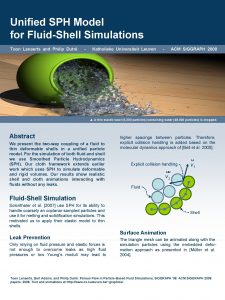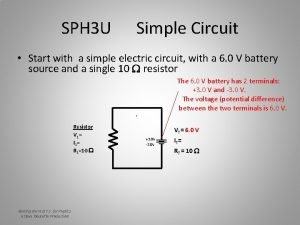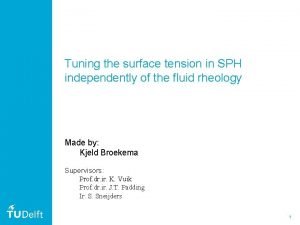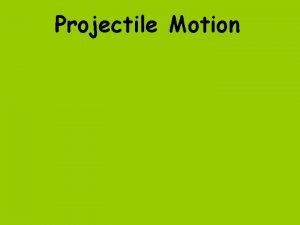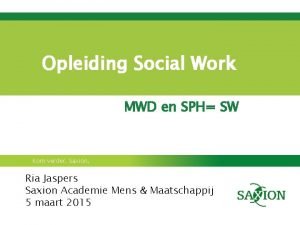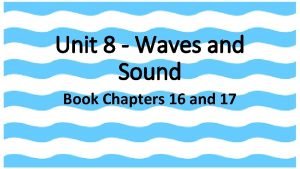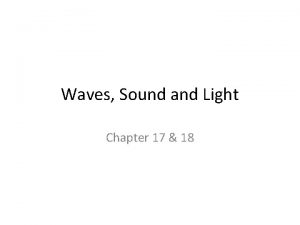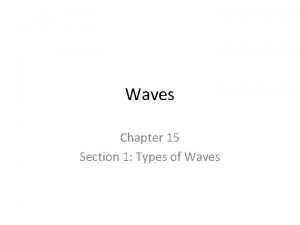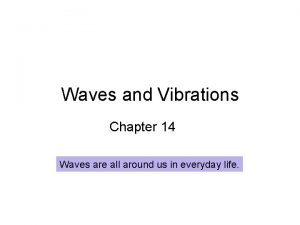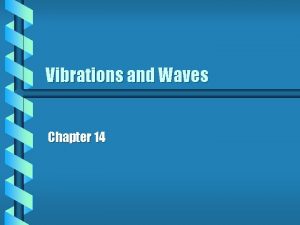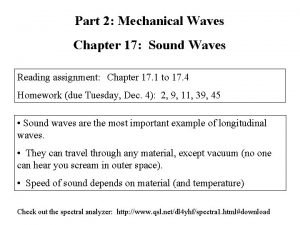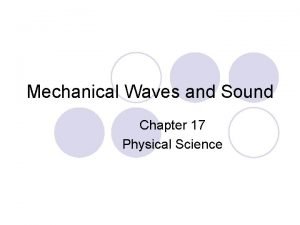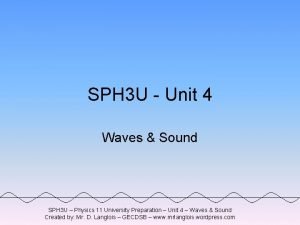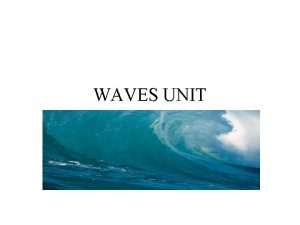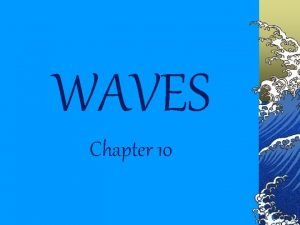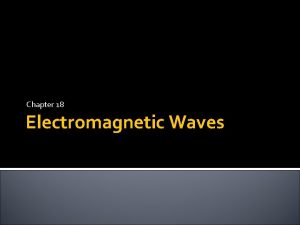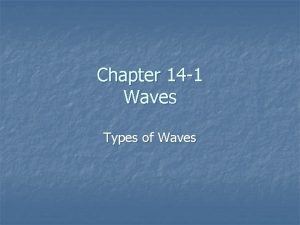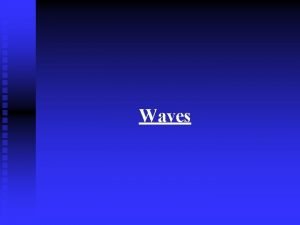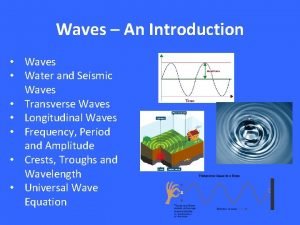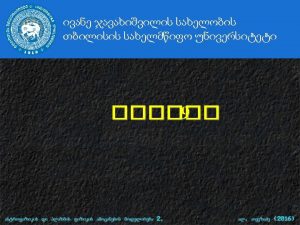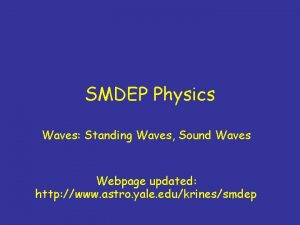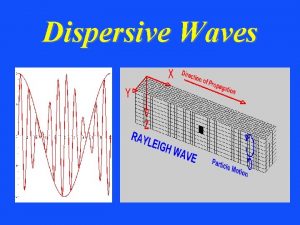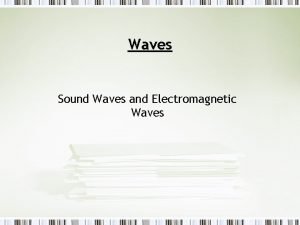SPH 3 U Unit 4 Waves Chapter 7







![Wave Terminology • Amplitude (A) [m] – the maximum displacement of a particle from Wave Terminology • Amplitude (A) [m] – the maximum displacement of a particle from](https://slidetodoc.com/presentation_image/5db0f1a9d76ed9ccd863972348e18f56/image-8.jpg)























- Slides: 31

SPH 3 U - Unit 4 Waves Chapter 7 SPH 3 U – Physics 11 University Preparation – Unit 4 – Waves & Sound Created by: Mr. D. Langlois – GECDSB – www. mrlanglois. wordpress. com

Vibrations • A _______ is a disturbance in a ____ created by a series of _____. • A medium is any type of material through which a wave may travel (eg: air, metal, glass, etc). ***The medium is the only factor which affects the speed of a wave!*** • A vibration is any type of back & forth movement. • There are 3 types of vibrations (we will only study the first two) SPH 3 U – Physics 11 University Preparation – Unit 4 – Waves & Sound Created by: Mr. D. Langlois – GECDSB – www. mrlanglois. wordpress. com

Propagation of a Longitudinal Wave SPH 3 U – Physics 11 University Preparation – Unit 4 – Waves & Sound Created by: Mr. D. Langlois – GECDSB – www. mrlanglois. wordpress. com

Propagation of Transverse Waves SPH 3 U – Physics 11 University Preparation – Unit 4 – Waves & Sound Created by: Mr. D. Langlois – GECDSB – www. mrlanglois. wordpress. com

Examples of Vibrations SPH 3 U – Physics 11 University Preparation – Unit 4 – Waves & Sound Created by: Mr. D. Langlois – GECDSB – www. mrlanglois. wordpress. com

Longitudinal vs. Transverse • http: //www. youtube. com/watch? v=Cswo. SQC_NX 0&NR=1 SPH 3 U – Physics 11 University Preparation – Unit 4 – Waves & Sound Created by: Mr. D. Langlois – GECDSB – www. mrlanglois. wordpress. com

Hmmmm… • What would a displacement-time graph of a particle experiencing a periodic vibration look like? SPH 3 U – Physics 11 University Preparation – Unit 4 – Waves & Sound Created by: Mr. D. Langlois – GECDSB – www. mrlanglois. wordpress. com
![Wave Terminology Amplitude A m the maximum displacement of a particle from Wave Terminology • Amplitude (A) [m] – the maximum displacement of a particle from](https://slidetodoc.com/presentation_image/5db0f1a9d76ed9ccd863972348e18f56/image-8.jpg)
Wave Terminology • Amplitude (A) [m] – the maximum displacement of a particle from its rest position during a vibration. • Cycle – one complete vibration from rest position to maximum amplitude in both directions and back again. • Wavelength (λ) [m] – the distance from one point on a wave to the same point in the next cycle. • Distance (d) [m] – the total distance a particle travels during one cycle of a vibration. • Period (T) [s] – the time it takes for one cycle of vibration. • Frequency (f) [Hz] –the number of cycles completed in one second. SPH 3 U – Physics 11 University Preparation – Unit 4 – Waves & Sound Created by: Mr. D. Langlois – GECDSB – www. mrlanglois. wordpress. com

Example 1. Find the Period of a car running at 3, 400 RPM. 2. Find the # of revolutions the engine performs in 3 seconds. SPH 3 U – Physics 11 University Preparation – Unit 4 – Waves & Sound Created by: Mr. D. Langlois – GECDSB – www. mrlanglois. wordpress. com

Practice • Problems on Waves and Vibrations Set #1 • Pg. 331 #1 -4 SPH 3 U – Physics 11 University Preparation – Unit 4 – Waves & Sound Created by: Mr. D. Langlois – GECDSB – www. mrlanglois. wordpress. com

Think about it… • Consider yourself sitting stopped at a railway crossing. How could you determine the speed of the train if you had a stop watch and knew the length of each railway car? SPH 3 U – Physics 11 University Preparation – Unit 4 – Waves & Sound Created by: Mr. D. Langlois – GECDSB – www. mrlanglois. wordpress. com

The Universal Wave Equation Let the train’s velocity be v Let the length of one car be λ Let the time it takes for one car to cross your field of view be T SPH 3 U – Physics 11 University Preparation – Unit 4 – Waves & Sound Created by: Mr. D. Langlois – GECDSB – www. mrlanglois. wordpress. com

Example 3. It takes a wave crest 0. 225 s to travel 3. 50 m. If the frequency of the source is 1250 Hz, what is its wavelength? SPH 3 U – Physics 11 University Preparation – Unit 4 – Waves & Sound Created by: Mr. D. Langlois – GECDSB – www. mrlanglois. wordpress. com

Practice • Problems on Waves and Vibrations Set 2 • Pg. 339 #5 -9 SPH 3 U – Physics 11 University Preparation – Unit 4 – Waves & Sound Created by: Mr. D. Langlois – GECDSB – www. mrlanglois. wordpress. com

Natural Frequency When an object is allowed to vibrate freely, such as a mass on a string (pendulum), it will tend to do so at a specific frequency, called its Natural Frequency. • Regardless of the amplitude or phase of the object, the natural frequency will remain the same! • (Ex: Try dropping a pendulum from different heights – the frequency remains constant). SPH 3 U – Physics 11 University Preparation – Unit 4 – Waves & Sound Created by: Mr. D. Langlois – GECDSB – www. mrlanglois. wordpress. com

Resonance Imagine pushing a child on a swing. It does not take a large force to make the child swing higher. What is required however is that you push at the RIGHT TIME - meaning, at the same natural frequency as the swing and child. In addition, the pushing cycle must be in phase with that of the child/swing. • When transfer of energy through a vibration is occurring from one object to a second object having the same natural frequency, it is called Resonance. SPH 3 U – Physics 11 University Preparation – Unit 4 – Waves & Sound Created by: Mr. D. Langlois – GECDSB – www. mrlanglois. wordpress. com

Phase • Two objects can have identical amplitudes, frequencies, and wavelengths, and yet be different because they are never at the same point in their cycles at the same time. The term Phase is used to describe this property. • We will use a pendulum as our example… • In Phase – when the pendulums are both at rest, or moving in the same direction at the same time. • Opposite Phase – when the pendulums are moving in opposite directions, equidistant from their rest positions at the same time. SPH 3 U – Physics 11 University Preparation – Unit 4 – Waves & Sound Created by: Mr. D. Langlois – GECDSB – www. mrlanglois. wordpress. com

Phase IN PHASE OPPOSITE PHASE SPH 3 U – Physics 11 University Preparation – Unit 4 – Waves & Sound Created by: Mr. D. Langlois – GECDSB – www. mrlanglois. wordpress. com

Phase • Out-of-phase- when the pendulums have the same amplitude and frequency but are not at the same point at the same time. The difference between the same point in their cycles is referred to as Phase difference. SPH 3 U – Physics 11 University Preparation – Unit 4 – Waves & Sound Created by: Mr. D. Langlois – GECDSB – www. mrlanglois. wordpress. com

Transmission & Reflection • Reflection – Fixed end reflections: same speed, inverted, same wavelength and amplitude – Not fixed end reflections: same speed, upright, same wavelength and amplitude • Transmission – When a wave travels into a different medium, two waves are formed; a transmitted wave into the new medium and a reflected wave back towards the old medium SPH 3 U – Physics 11 University Preparation – Unit 4 – Waves & Sound Created by: Mr. D. Langlois – GECDSB – www. mrlanglois. wordpress. com

Transmission & Reflection SPH 3 U – Physics 11 University Preparation – Unit 4 – Waves & Sound Created by: Mr. D. Langlois – GECDSB – www. mrlanglois. wordpress. com

• W: Wavelength • A: Amplitude • V: Velocity • O: Orientation Summary Heavy (slow) -> Light (fast) Reflected Wave W A V O Light (fast) -> Heavy (slow) Transmitted Wave Reflected Wave W A V O SPH 3 U – Physics 11 University Preparation – Unit 4 – Waves & Sound Created by: Mr. D. Langlois – GECDSB – www. mrlanglois. wordpress. com Transmitted Wave

Wave Interference • When multiple waves disturb the same medium simultaneously, the resultant movement of the medium is the combination of the movement caused by each individual waves. SPH 3 U – Physics 11 University Preparation – Unit 4 – Waves & Sound Created by: Mr. D. Langlois – GECDSB – www. mrlanglois. wordpress. com

Principle of Superposition • When two or more waves are present simultaneously in the same place, the resultant wave is the sum of the individual waves. SPH 3 U – Physics 11 University Preparation – Unit 4 – Waves & Sound Created by: Mr. D. Langlois – GECDSB – www. mrlanglois. wordpress. com

• The resultant wave is larger than either individual (component) wave. • Total constructive interference occurs when the resultant wave’s amplitude is at a maximum. SPH 3 U – Physics 11 University Preparation – Unit 4 – Waves & Sound Created by: Mr. D. Langlois – GECDSB – www. mrlanglois. wordpress. com

• The resultant wave is smaller than either component wave. • Total destructive interference occurs when the wave’s amplitude is at a minimum (creates a node). SPH 3 U – Physics 11 University Preparation – Unit 4 – Waves & Sound Created by: Mr. D. Langlois – GECDSB – www. mrlanglois. wordpress. com

Standing Waves • When two identical waves travel in opposite directions, a special type of interference pattern emerges. SPH 3 U – Physics 11 University Preparation – Unit 4 – Waves & Sound Created by: Mr. D. Langlois – GECDSB – www. mrlanglois. wordpress. com

Standing Waves • At intervals that are a _________, the wave destructively interferes and creates ______ that never move. Between each node, an _____ vibrates maximally. Since the nodes do not move, the sense of movement of the two component waves is lost which creates a standing wave. SPH 3 U – Physics 11 University Preparation – Unit 4 – Waves & Sound Created by: Mr. D. Langlois – GECDSB – www. mrlanglois. wordpress. com

Example • The distance between adjacent nodes in the standing wave pattern produced in a piece of string is 25. 0 cm. a) What is the wavelength of the wave in the string? b) If the frequency of vibration is 200 Hz, calculate the velocity of the wave. SPH 3 U – Physics 11 University Preparation – Unit 4 – Waves & Sound Created by: Mr. D. Langlois – GECDSB – www. mrlanglois. wordpress. com

Modes of Vibration • Fundamental mode is the standing wave pattern for a medium vibrating at its fundamental frequency and displays the fewest number of nodes and antinodes • Overtones are multiples of the fundamental frequency which will produce a standing wave pattern in the same medium. SPH 3 U – Physics 11 University Preparation – Unit 4 – Waves & Sound Created by: Mr. D. Langlois – GECDSB – www. mrlanglois. wordpress. com

Diffraction SPH 3 U – Physics 11 University Preparation – Unit 4 – Waves & Sound Created by: Mr. D. Langlois – GECDSB – www. mrlanglois. wordpress. com
 Sph toon
Sph toon Netgear sph
Netgear sph Sph +3
Sph +3 Ohsu sph
Ohsu sph Sph 4 inches
Sph 4 inches Sph surface tension
Sph surface tension Sph cah toa
Sph cah toa Sph saxion
Sph saxion What waves do not require a medium
What waves do not require a medium Electromagnetic waves are longitudinal waves true or false
Electromagnetic waves are longitudinal waves true or false A matter in which waves can travel and transfer energy
A matter in which waves can travel and transfer energy Mechanical waves and electromagnetic waves
Mechanical waves and electromagnetic waves What type of waves are sound waves? *
What type of waves are sound waves? * Whats a reflected sound wave
Whats a reflected sound wave What is a semiconductor used for
What is a semiconductor used for Difference between matter waves and electromagnetic waves
Difference between matter waves and electromagnetic waves Mechanical vs electromagnetic waves
Mechanical vs electromagnetic waves Mechanical waves and electromagnetic waves similarities
Mechanical waves and electromagnetic waves similarities Surface waves and body waves
Surface waves and body waves Seismic waves are mechanical waves
Seismic waves are mechanical waves Compare and contrast p waves and s waves using venn diagram
Compare and contrast p waves and s waves using venn diagram Electromagnetic and mechanical waves
Electromagnetic and mechanical waves The difference between constructive and destructive waves
The difference between constructive and destructive waves Unit 10, unit 10 review tests, unit 10 general test
Unit 10, unit 10 review tests, unit 10 general test Sound waves unit 21
Sound waves unit 21 Sound waves unit 8
Sound waves unit 8 Different types of mechanical waves
Different types of mechanical waves The wave chapter 15
The wave chapter 15 The wave chapter 14
The wave chapter 14 Chapter 14 vibrations and waves
Chapter 14 vibrations and waves Chapter 17 mechanical waves and sound wordwise answer key
Chapter 17 mechanical waves and sound wordwise answer key Which travels along a surface separating two media
Which travels along a surface separating two media
